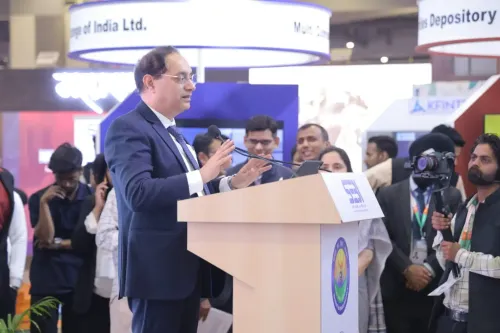How is India’s TV viewership reaching 900 million across 230 million households?

Synopsis
Key Takeaways
- India's television network connects 900 million viewers.
- Over 230 million households have access to television.
- 918 private satellite channels are operational.
- DD Free Dish plays a crucial role in digital inclusion.
- The M&E sector is projected to exceed Rs 3 lakh crore by 2027.
New Delhi, Nov 21 (NationPress) India’s television network now reaches 900 million viewers across 230 million households, with 918 private satellite channels currently operational as of March 2025. This underscores the country’s dynamic broadcast landscape. Notably, there are around 6.5 crore DD Free Dish homes, promoting digital accessibility and free public access, as per official statistics released today on the occasion of World Television Day.
The Media and Entertainment (M&E) sector of India contributed an impressive Rs 2.5 lakh crore to the economy in 2024 and is expected to surpass Rs 3 lakh crore by 2027. Within this sector, the television and broadcasting segment alone generated nearly Rs 680 billion in 2024. The growth trajectory is fueled by advancements in digital technology, including 4K broadcasting, Smart TVs, 5G, and OTT platforms catering to over 600 million users, as reported in an official statement.
Every year, World Television Day is celebrated globally on November 21, following a proclamation by the United Nations General Assembly through a resolution adopted in 1996. This day acknowledges television's crucial role in informing, educating, and shaping public opinion while promoting communication and global understanding.
In India, the day is celebrated under the auspices of the Ministry of Information and Broadcasting (MIB) and its public broadcasting entity, Prasar Bharati. Initiatives and outreach programs by Doordarshan and All India Radio emphasize television's lasting significance in public service communications, dissemination of developmental messages, and encouragement of national unity.
The evolution of television in India, from a limited experimental service initiated in 1959 to one of the globe's largest broadcasting networks, exemplifies the nation's advancement in communication technology, public engagement, and digital innovation. Guided by the Ministry of Information and Broadcasting, India’s television journey reflects the country's socio-economic growth, transitioning from community educational broadcasts to a fully digitized, multi-channel environment as stated.
The introduction of color television in 1982, coinciding with the Asian Games in New Delhi, marked a pivotal moment in India’s broadcasting narrative. This era witnessed rapid expansion of terrestrial transmitters under Doordarshan, enhancing reach to rural and remote areas.
The television landscape has now entered a transformative phase driven by digital evolution, featuring innovative technological advancements, multilingual content, and inclusive access. Modern broadcasting trends such as high-definition and satellite expansion, along with emerging AI-driven tools, facilitate regional language content creation, real-time subtitling, and interactive programming. These innovations ensure that television remains an inclusive medium, bridging linguistic, cultural, and digital divides across the country.
Since its launch, DD Free Dish has experienced remarkable growth in channel offerings, soaring from 59 channels in 2014 to 482 channels in 2025, thereby broadening access to a diverse array of national, regional, and educational content. As a free-to-air Direct-to-Home (DTH) platform, DD Free Dish plays a crucial role in extending television access in India, particularly in remote, border, and underserved areas. This service complements the digital terrestrial network of Doordarshan, ensuring reliable access to a wide range of content.
Supported by governmental initiatives in digital infrastructure, public service broadcasting, and content innovation, television is transitioning from a one-way communication channel to a participatory platform that reflects India's diverse voices. It continues to enhance awareness, foster inclusion, and shape a connected, informed, and empowered India, reaffirming its essential role as a cornerstone of national communication.









